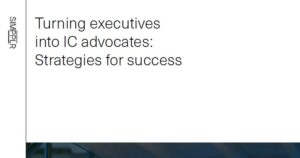Top 2021 internal communication trends
Here’s what to expect—and prioritize—in what’s sure to be another turbulent year ahead.

2020 has squeezed us all through the wringer in multitudes of ways.
It’s been a year shaped and contorted by a deadly virus, social distancing, pain and protests. We’ve all sacrificed and struggled to adjust while juggling work and home responsibilities. The chaos has been nonstop. And yet the prospect of a new year—even with a frightening pandemic still very much in high gear—offers a bit of hope for communicators around the world.
Who knows what surprises 2021 will hold? Surely things will improve?
If 2020 taught us anything, it’s to expect the unexpected and to be ready to “pivot” at a moment’s notice. (With all due respect to “pandemic” or “unprecedented,” “pivot” should be the word of the year, right?)
Here’s what comms leaders and luminaries foresee for the year ahead:
Top 2021 comms trends
One of 2020’s bright spots has been the global reawakening toward the evils of systemic racism. In the wake of widespread protests after George Floyd’s horrific death in Minneapolis, companies hither and yon pledged to “do better” and scrambled to affirm that black lives do, indeed, matter. But what do we have to show for all the social media solidarity and bold corporate statements?
Elizabeth Cogswell Baskin, CEO of Tribe Communications, says meaningful action on the DE&I front should be treated as a key business concern in the new year. She says:
“We predict a lot more attention on inclusion and diversity in 2021, including communications that focus on company actions rather than just raising the issue.”
Baskin points to another silver lining from 2020, which is an increased focus on employees’ mental health. “We’re also seeing increased concern around employee mental health as a response to prolonged work-from-home arrangements,” she says, “And we expect more focus on replacing or improving intranets, as a way to keep remote workforces connected and engaged.”
Change communication expert Annique Simpson believes 2021 will be the year of “humanity”—and that companies must go deeper than offering superficial support in this time of deep pain. She says:
“2020 will be defined by the word ‘humanity’—its power, its fragility, its necessity. Communicators will need to continue to explore the behavioral sciences—such as psychology, behavioral economics, sociology—to ensure our strategies and messages remain as humane as possible in 2021 and beyond.”
2021 should be centered on employee health and wellness—but how well you communicate offerings can make or break your efforts. Traci McBee, spokesperson for Wellmark Blue Cross and Blue Shield, offers a reminder that millennials, in particular, merit specific interventions. “By 2025, millennials will comprise more than 75 percent of the American workforce,” she says. Citing data from Wellmark’s research into millennial health, McBee advises, “One of the biggest takeaways was the need to provide online tools to help improve access to information. This generation is no stranger to technology, and they’re looking for platforms and apps to see their health records, manage costs and easily shop around for different types of care. During our listening sessions, millennial participants were clear: When online tools are not simple and easy, they won’t use them. Even more, they are willing to share more information and data when the process is simple and understandable.”
The ongoing chaos of the pandemic is also shaking loose some opportunities for enterprising, strategic storytellers. April Kaull, executive director of communications for West Virginia University, says it’s wise to hitch your media relations wagon to hot stories that are driving the lion’s share of news coverage. While uncouth or irrelevant newsjacking can backfire, tying your pitch to a trending topic can catch a reporter’s eye.
“While news coverage of the pandemic, election and racial injustice created challenges for those seeking earned media in recent months, savvy marketing and communications teams discovered some unique opportunities,” Kaull says.
Her team continues to cultivate a deep bench of media-prepped subject matter experts who can speak with journalists on niche topics. “We found success in leveraging the expertise of our faculty, staff and students in places where it intersected with the news of the day. Moreover, we experienced the best outcomes when that intersection also supported our core messaging mission which centers on education, broad based prosperity and health care.”
Prioritizing workers’ well-being—and truly embracing flexibility
2020 has been a year of swift change. Perhaps the most profound shift has been employees’ attitudes toward workplace expectations and work experience. With most of us still working from home—and many unprepared or unwilling to return to an office—companies are scrambling to adjust to a remote-workforce business model.
Sammy Courtright, co-founder of Ten Spot, says the pandemic has hastened what’s been a long time coming—namely, “hybrid” work flexibility. “For the past decade the idea of a hybrid workforce has been a vision for the future, but the COVID-19 pandemic rapidly accelerated the timeline. Now 75% of workers want to keep this flexibility even after it’s safe to go back to work so they can abandon their commutes, feel more comfortable as they work, and spend more time with their families.”
To achieve long-term success, Courtright says companies must reconsider how they view and pursue employee benefits, engagement, and wellness. She says that beyond consistent mental health check-ins and home office technology investment, companies should strive to create robust cultures that accommodate our distanced era.
She says communicators should consider:
- How do we help new hires form relationships with their colleagues in the era of remote work?
- How do we help new and existing hires have a voice in this company when they have never met co-workers, or haven’t seen co-workers in months?
- Are we creating micro-moments of belonging?
- Are we creating an empowering environment that allows employees to stay connected?
Flexibility will be the name of the game in 2021, according to Shira Miller, chief comms officer of National DCP—the $2 billion supply chain management company serving the franchises of Dunkin’. “We are going to have to be mindful and flexible in defining what it means to communicate effectively in 2021,” she says. “It is going to be a time of transition. Based on current trends, the population could be coping with increased shutdowns and continued COVID-19 spread throughout the winter, keeping the stay-at-home model of working, learning, shopping and socializing in place until approved vaccines are widely distributed.”
“Even then,” she says, “it feels like we will be crafting a new normal in communicating with employees, customers, shareowners, business partners and other key audiences.”
Miller predicts the following comms trends will be crucial in the coming year:
Greater authenticity. “Traditionally, the C-suite was about reassuring target audiences that they had everything under control when crises hit,” Miller says. Now, it’s about “keeping it real” and show genuine human emotion. Leaders should communicate with transparency by “acknowledging the pain felt by employees, customers and the country overall.” Honest, unvarnished messaging of that nature makes execs more accessible and likeable—and seem more trustworthy.
“Retreating back to a shell of controlled perfectionism would be a regression that harms earned trust as the pandemic subsides and certain sectors of the economy rebound,” Miller says.
Increased focused on social responsibility. CSR efforts have become more than token charitable giving. Miller says that in 2021, “social responsibility will become a must-have in recruiting and retaining employees, connecting with customers and satisfying shareowners.”
More options for on-demand content. Miller notes that large group meetings and gatherings will mostly be off the table throughout 2021, which presents unique messaging challenges. To keep weary remote workers engaged, look for an ongoing stream of diverse content on a multitude of platforms. “Organizations will continue to rely on video meeting platforms to promote engagement while also exploring more options for on-demand communications content such as company podcasts, increased storytelling in newsletters and video channels and more.”
Over to you, communicators. Which trends will soar in 2021? What channels, tactics or platforms will fade? Leave your thoughts and hot takes in the comments below.







